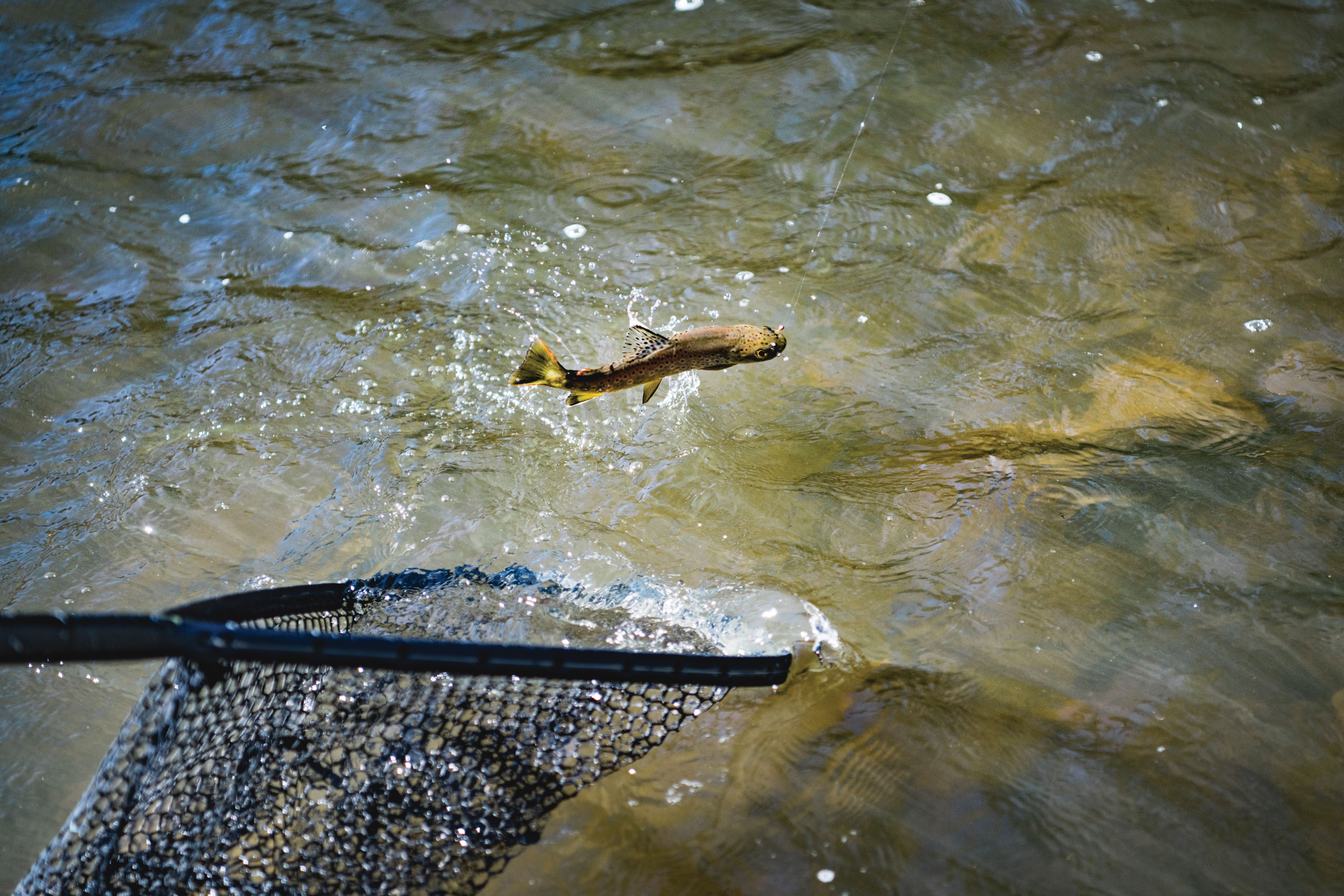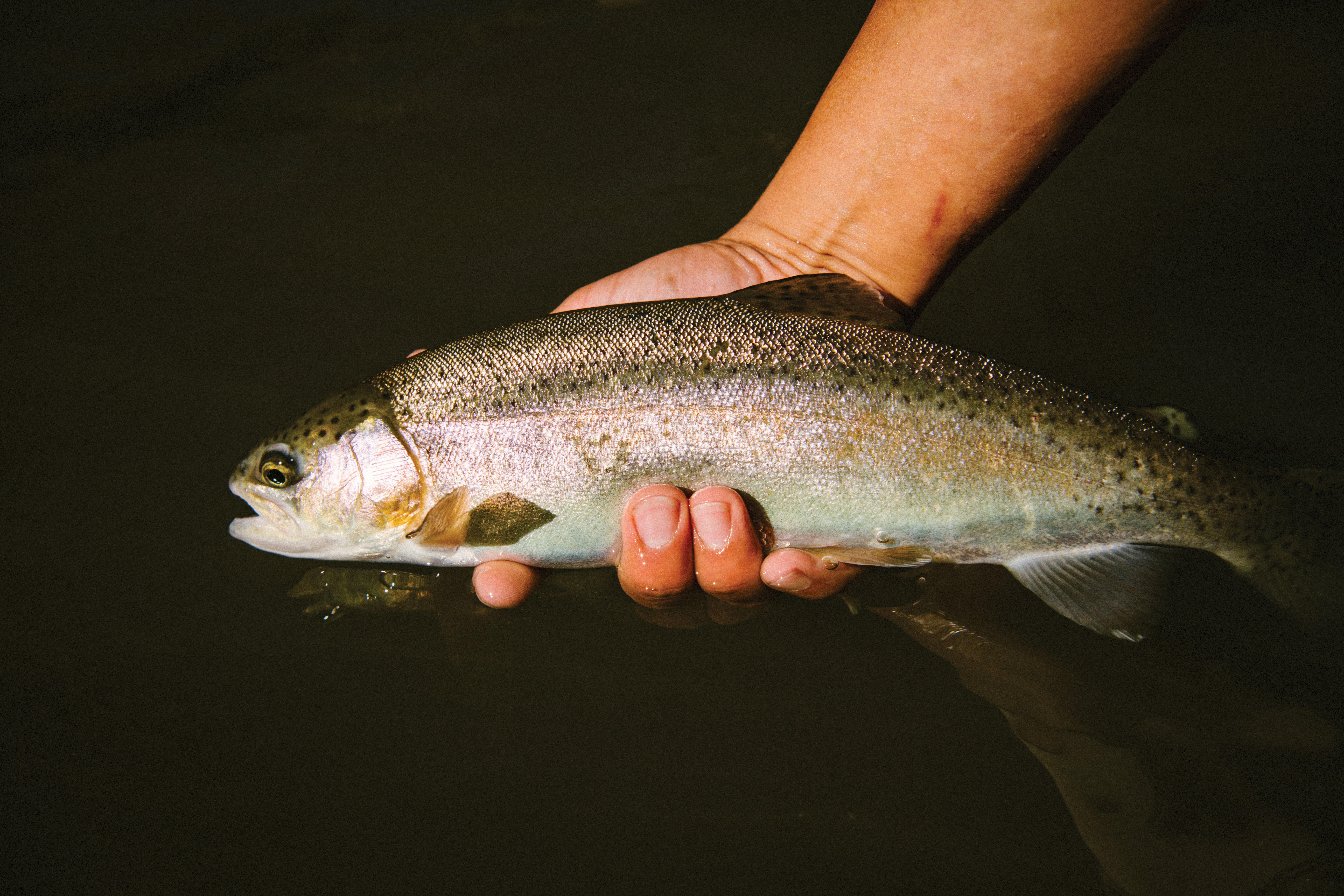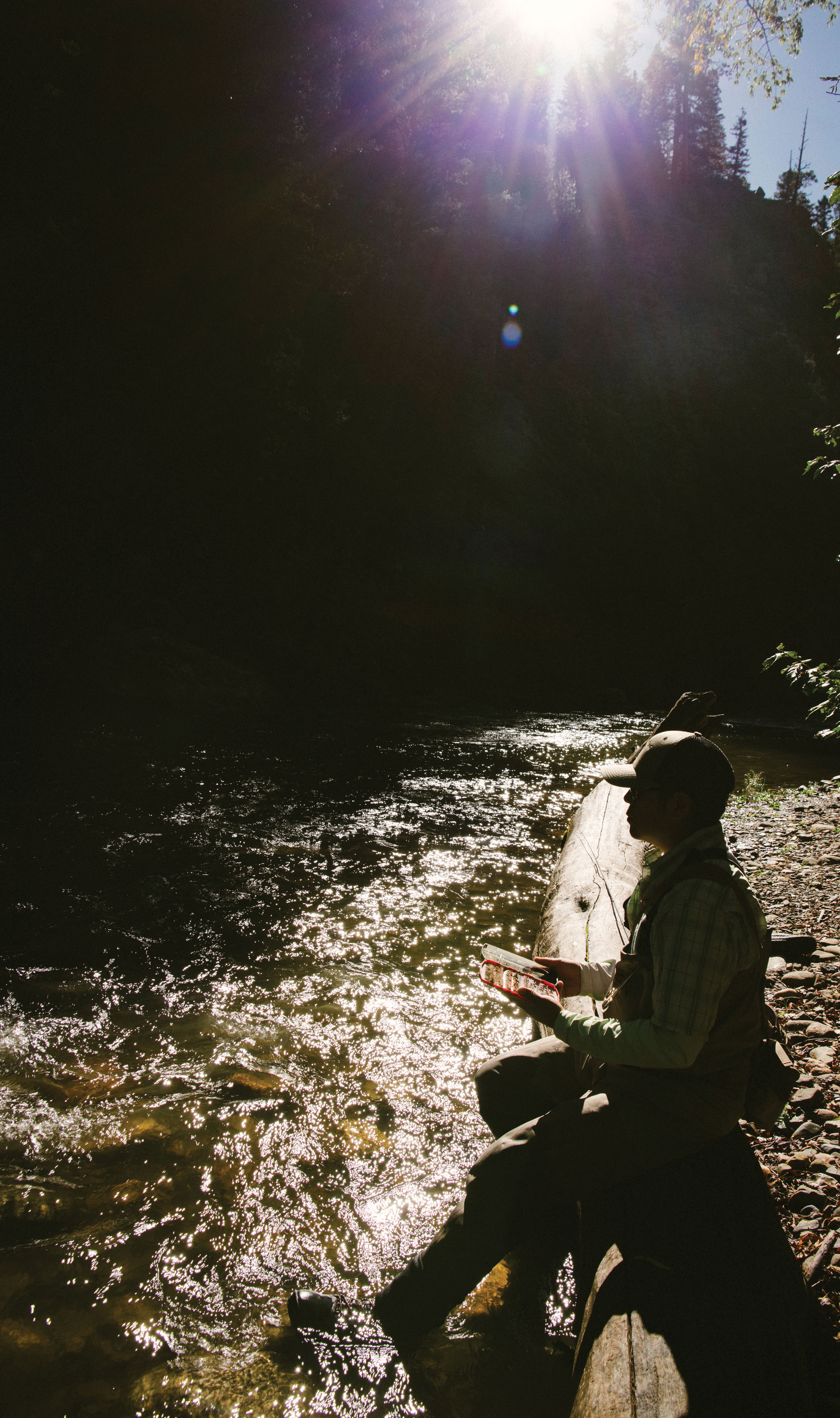Above: Norman Maktima fly-fishing in the Pecos River. Photographs by Andrew Kornylak.
THE RÍO CHAMA FLOWS cold and green below Abiquiú Dam, north of Española. Some of us might look at the river and see the relative clarity on its edge turn to olive murkiness in the deeper runs and pools. Maybe we notice the flocks of ducks or the red rocks and yellow earth of the canyon walls. Fly-fishing guide Norman Maktima looks harder and deeper, his trained eye seeing what’s below the surface—the water column and hydraulics that influence the movement and sink rate of his flies as he tries to woo the trout lurking below.
The San Felipe Pueblo tribal member takes every part of his chosen profession of fly-fishing seriously. He guides. He competes in national and international competitions—and wins. He’s developed a signature line of flies and designed his own fly rods. He makes YouTube videos. Fishing with Maktima is like skiing with someone who has been to the Olympics or sitting down to play guitar with Eric Clapton.
“Fly-fishing is several arts and sciences rolled into one sport,” he says. “All the techniques and tactics I’ve learned I utilize in helping clients catch fish and understand what’s going on. Everything has a spirit. Trout have a spirit as well.”
IN ENGLAND, fly-fishing got its largely self-awarded reputation as a genteel sport for those of an aristocratic class and character with the 1653 publication of Izaak Walton’s The Compleat Angler, or the Contemplative Man’s Recreation. “O, Sir,” Walton opines, “doubt not but that angling is an art … and an art worth your learning: the question is rather, whether you be capable of learning it? For angling is somewhat like poetry, men are to be born so.”
Beginning around World War I, and under an influential group of largely New York–based authors and anglers, American fly-fishing adopted a tweedy, quasi-British aesthetic. Half a century later, the sport gave birth to a new wave when Trout Bum, by John Gierach, was published in 1986 and became the true voice of those who chased fish all over the West and beyond (or who aspired to do so deep in their hearts). Gierach’s essays planted the fly-fisherman’s dream of simply getting by: sweeping just enough floors, tying just enough flies to sell, writing just enough fishing reports for a local paper. All to get cash for coffee, Twinkies, and gas in an ascetic’s search for wild trout in pristine places. The thought of actually making a living from fly-fishing? Dream on.
Enter Norman Maktima.
Now 38, Maktima, who also has roots in Hopiland and Laguna Pueblo, grew up in Pecos, where his father began teaching him fly-fishing. He was recognized as a phenom when he joined the U.S. Youth Fly Fishing Team, helping it win silver at the first World Youth Fly Fishing Championship in 1998 while taking the individual gold medal himself. Fly-fishing as competitive sport comes with a fair number of rules, but the bottom line is this: Whoever catches the most fish of a certain size or greater within a set amount of time on a specific stretch of water wins. Last year, Maktima won the individual event at the National Fly Fishing Championships. He has represented the United States several times in international competitions as a member of Team USA. Early in his career, he attended guide school at Clark Fork River Outfitters, in St. Regis, Montana, and has been taking clients fly-fishing on the Pecos and Chama Rivers and throughout northern New Mexico for 22 years, averaging about 90 days on the river per guiding year.
But he is no trout bum. Maktima is a professional angler, proudly Native American in a sport that he readily acknowledges appeals to a largely white audience, a man who definitely makes a living from fly-fishing and, even on days when he fails to land a single fish or must endure a difficult client, still loves it.
 Above: Catching trout in Pecos River.
Above: Catching trout in Pecos River.
“Guiding can definitely overwhelm and tire you,” he says.
“Especially after a long summer, a good summer season, you’re pretty burned out, so finding those moments is definitely appreciated.” He’s leaning on the counter at High Desert Angler, in Santa Fe, where he is head guide, a few months before the busy summer season.
“At the end of the day on a guide trip, if you knock off early, you have an hour or two where you can go fish for a little bit. If I’m going into competition, I’ll designate one or two hours to work on certain techniques, like different rigs, different flies, different approaches. After I’m done with that, I’ll just fly-fish however I want to fish. I don’t have to stay within the boundaries of competition—I’ll just go have some fun and enjoy the rest of my day, or I’ll split it up into fishing and then go for a run. Hit the trail, then have a little soak in the river. And that’s my day.”
FLY-FISHING LIKELY REACHED New Mexico with the wave of Anglo settlers in the 1800s, says Kirk Patten, chief of fisheries for the state Game and Fish Department. His agency doesn’t separate fly-fishing from other types of fishing, but he estimates that fishing of all types adds up to 3.6 million days of adventure every year in New Mexico. One estimate says fly-fishing on the San Juan River alone produces more than $20 million a year. Fishing license fees and taxes on tackle and boat fuel help fund fish hatcheries and conservation along the state’s waterways. While you can fly-fish here for several types of bass and other species, some fly-fishing purists are after two native species: the Río Grande cutthroat trout and the Gila trout.
Maktima and I have catch-and-release eyes on the former.
Our trip to the Río Chama starts in the parking lot of High Desert Angler as Maktima loads gear into his four-year-old SUV, which already has 180,000 miles on it. He checks the river’s streamflow on his phone via a link on the fly-shop web page. Identifying the volume helps him formulate an initial plan for hitting the river.
Along the drive up, Maktima and I fill the vehicle with tales of rivers we’ve fished (here for me and abroad for him), memorable catches, and sobering moments. While Slovenia and Italy stand out in Maktima’s mind from all of his international travel with Team USA, he says that a trip to Bosnia left the deepest mark. There, the 1990s Bosnian War should have seemed like a distant memory, but people still grappled with postwar poverty and bullet holes still marked the walls of buildings.
Maktima is quickly shaken free of the memory by a don’t-miss stop along the drive: Bode’s General Store, in Abiquiú, for coffee and breakfast burritos. We grab and go, eating as we take a short drive to Abiquiú Dam, then down the road traversing its face, from which the late-winter Río Chama flows. Maktima wipes the remnants of green chile and cheese from his lips as he pulls into a parking area. We stay only long enough to put on waders before driving just a bit farther. Numerous ducks float the slow sections of the river that we bypass. Herons flap slowly above the river, two of them looking like pterodactyls.
Having been on the river two or three times a week in the winter months for the past seven years or so, Maktima is intimately familiar with the Chama. He knows the rocks lining the bottom of the streambed and how the current flows over them. The amount of water released by dam managers, per the needs of downstream users, such as farmers and the pueblos between Santa Fe and Albuquerque, also affects the currents, the river’s width, and the depth of its pools. The changes in flow impact the fish as well, which have to adjust to new conditions in their habitat, a process that can take up to a few days. Even with these changes, Maktima prefers the relative stability of the Chama to the even greater fluctuations on the Río Grande at Pilar, south of Taos—another popular fly-fishing site. Years of competition led him to see beyond the mere surface of a river or lake and instead to consider how its structure alters the flow of water and changes where the fish might hide. “Hydraulics affect everything,” he says.
THE WIND HOWLS AROUND the eternal blue mesas west of the river. Ancient gnarled and gray cottonwoods stand guard as Maktima tries to coax a fish out of a difficult stretch of water. On the opposite bank, a crew from a downstream acequia cleans the adjacent ditch in advance of spring irrigation. There are easier stretches of water, Maktima says, but here is where the bigger, wild trout reign. Given a choice, Maktima will trade quality of fish over quantity anytime.
In the river, Maktima selects flies from a large rectangular box, one of many he carries for guiding and competition. While many anglers strive to present flies that closely imitate the aquatic insects of the river being fished, Maktima’s attractors sport silver beads and bright colors that are intended to give the trout something they don’t see all time, something different from the traditional imitator patterns used by most fly-fishers.
 Above: Catching trout in Pecos River.
Above: Catching trout in Pecos River.
From a downstream position, he casts his flies upstream to drift down lanes that he mentally divided the river into. If a fly doesn’t work, he replaces it. Changing flies or techniques is not a sign of indecision, Maktima notes. It’s an opportunity to alter a factor that might be leading to failure. Even if everything’s working right, he’ll change flies or a technique just to see what else might work under those circumstances. Also, competition breeds speed. Maktima can tie a new fly on his line as fast as if he were snapping them on. Each cast embodies the intersection of science and art.
“You’re dealing with the physics of the fly rod, you’re dealing with ichthyology, with the behavior of fish, with the behavior of aquatic insects, with hydrology, and with the science of riparian environments,” he says. “Then there’s the art of fly-casting, the art of fly-tying, even the art of fighting fish. That is a whole other aspect.”
Great guides are not born. Maktima spent weeks learning all aspects of the business, with a primary focus on how to relate to clients as individuals. Do they just want to fish in a new region? Do they need instruction? “With all the experience I’ve had in fly-fishing—competition, traveling, learning from other people in the industry—the guiding definitely is sharing, giving that back. Typically my guiding turns into almost a class-type scenario.”
Sandia National Laboratories scientist Nathan Schwade hired Maktima to guide him and his 13-year-old son earlier this year. “He has a way of teaching it to you so that it’s broken down,” Schwade says. “A lot of people who are experts forget what they didn’t know, so they can’t remember what it was like. For us, this is a long-term thing. We don’t want to just catch some trophy fish and go home. We want to really learn how to do it.”

Above: Norman Maktima.
Sometimes that means Maktima talks a client through the cast, or analyzes the drift of a fly on or in the water, or explains what he’s doing as he changes a fly. Other times, he just goes quiet. “If I’m not saying anything, you’re good. You’re doing everything right. If you’re good and solid, just keep doing what you’re doing.”
The biggest lesson that Schwade and his son took home wasn’t about technique, but a worldview. “The ability to learn about the whole ecosystem, about nature and respect for nature, has been helpful,” he says.
For that, Maktima sometimes teaches by example. “I’ll take the time when I’m guiding to move from spot to spot, to look around and get that experience of being in the outdoors,” he says. “I’ve seen weasels, otters on the Río Grande, eagles, and different birds that are migrating through the area. Flowers, if we had a good snow year, bighorn sheep. There’s things other than fish that make the experience.
Read more: Three Great Hikes to Waterfalls.
“The traditions I have and what I have learned on the cultural aspect of being Native does influence how I approach this. It’s a lot of how I carry myself out on the river,” he says, and laughs. “I’ve gotten some grief from some clients when I start talking about the birds more than the fishing, or the flowers, and they’re like, ‘We’re here to fish.’”
THOSE WHO CAN'T HIT the river with Maktima can glean the essence of his teaching from his numerous online videos. He credits John Ray, of Laguna and Acoma Pueblo heritage, for upping his game in the online world. He shows his gear, demonstrates casts, even airs his mistakes in order to analyze them. His videos and his Instagram feed feature something you don’t see a lot of elsewhere: a Native American fly-fishing. That’s part of his initiative to make the sport more inclusive. “There’s a group of Native women who wanted to get involved in fly-fishing who created this informal Pueblo women’s fly-fishing group,” he says. “That spurred me on to find other individuals on social media, on Instagram, that I started to follow.”
 Above: Maktima crafts his own flies and, rather than making imitators of aquatic insects, prefers attractors that get the trout's attention.
Above: Maktima crafts his own flies and, rather than making imitators of aquatic insects, prefers attractors that get the trout's attention.
Now he encourages other Native fly-fishing professionals, from Wyoming and Montana, to come to New Mexico to teach and inspire others, while carrying on his own teaching and talks at venues that include High Desert Angler, Santa Fe’s Institute of American Indian Arts, Santo Domingo Pueblo, and, in Albuquerque, Los Pinos Fly & Tackle and even Tingley Beach, on a family fishing day. Sharing his passion also includes a recent effort in which he consulted on a stream-restoration project for a Pueblo tribe, working to ensure that its recreational value was honored.
“The greatest reward is getting people to enjoy the sport,” he says. “It’s always rewarding when I know that I have influenced someone and they have either taken up fly-fishing as a sport or I have helped them improve their ability in the sport.”

STREAMING SERVICE
High Desert Angler offers a variety of guided excursions for beginners and advanced fly-fishers. Half-day trips begin at $300 a person, full days at $350—all catch-and-release. In the off-season, staff members hold workshops on casting, fly-tying, and other techniques (460 Cerrillos Road, Santa Fe; 505-988-7688).
GO FISH
Fly-fishers adore waters throughout New Mexico, but especially the northern reaches of the state. June is a great month to get out. Here are four favorites to get you started:
Río Chama. Wait for winter, when cold water flows from the Colorado mountains through red canyons, across luscious meadows, and out of Abiquiú Lake. Guide services and fishing cabins are available in Chama.
Río Grande. From the Colorado state line down to its confluence with the Río Chama, north of Española, the state’s big river and its tributaries, the Red River and the Río Pueblo de Taos, combine a stunning landscape with nearby lodgings and restaurants. Spring through summer, snowmelt and rain muddy the water, but fall is a wondrous time to be on this river.
San Juan River. Below Navajo Lake’s dam, the San Juan River is known for world-class fishing that everyone from beginners to experts can enjoy. The area has great amenities, guides, fly shops, and campgrounds and is close enough to Aztec, Bloomfield, and Farmington to pick up whatever you forgot to pack.
Gila River. While it roars with snowmelt in the spring, the Gila slims to barely even a creek in the summer. Start with the Middle Fork—and bring plenty of gear. You’re hours away from civilization, deep in a rugged and magnificent wilderness.
The state Game and Fish Department has information about licenses, seasons, and boating regulations, plus a weekly fishing and stocking report.


